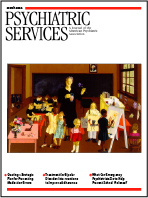Trauma and Tragedy in New York City
To the Editor: Dr. Satel contends in her editorial in the December issue (1) that posttraumatic psychopathology never really materialized among New Yorkers after the terrorist attacks of September 11, 2001.
A concerning aspect of this analysis is the unintended effect it may have if it is interpreted as a dismissal of the trauma experienced by the people of New York. Widespread subsyndromal posttraumatic stress disorder (PTSD) disrupts communities, both psychologically and economically. We know from important scholarly work led by the New York Academy of Medicine that persons who were exposed to the attacks did suffer in greater proportions than those who were not (2). In addition, Weissman (3) showed a statistically significant rise in PTSD treatment after September 11, 2001, albeit without clear causality.
Our challenge is to devise methods to reliably measure and intervene when broad social trauma strikes so that the mental health system can provide essential clinical services, and, in so doing, improve the mental health and social and economic conditions of affected communities.
Dr. McQuistion is chief medical officer for mental hygiene services in the City of New York Department of Health and Mental Hygiene.
1. Satel SL: The mental health crisis that wasn't. Psychiatric Services 54:1571, 2003Link, Google Scholar
2. Galea S, Vlahov D, Resnick H, et al: Trends of probable post-traumatic stress disorder in New York City after the September 11 terrorist attacks. American Journal of Epidemiology 158:514–524, 2003Crossref, Medline, Google Scholar
3. Weissman EM, Kushner M, Marcus SM, et al: Volume of VA patients with posttraumatic stress disorder in the New York metropolitan area after September 11. Psychiatric Services 54:1641–1643, 2003Link, Google Scholar



